|
|
|
Sort Order |
|
|
|
Items / Page
|
|
|
|
|
|
|
| Srl | Item |
| 1 |
ID:
188341
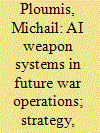

|
|
|
|
|
| Summary/Abstract |
In the future, at the strategic, operational and tactical level of warfare, the substitution of the human will and action by autonomous AI weapon systems appears quite probable. These systems are already being used and have the capability to successfully deal with threats faster than humans. The countering of AI weapon systems will pose a great challenge in a future war. In this article, the case is made that for the AI weapon systems to be defeated, unconventional cognition will be required.
|
|
|
|
|
|
|
|
|
|
|
|
|
|
|
|
| 2 |
ID:
188347
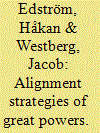

|
|
|
|
|
| Summary/Abstract |
The article aims to contribute to previous research in two main ways. First, we intervene in the debate on the stability of the present unipolar system by offering an analytical framework and an empirical approach for exploring and categorizing the actual strategies pursued by the major powers in the contemporary international system. In doing so, we present an analysis of how the strategies of the five system-determining states interact and affect the stability of the system. Second, in order to be able to explain why states pursue different strategies, we complement the analytical framework of structural realism with insights from research on Power Transition Theory (PTT). Hereby, we offer a new comprehensive theoretical approach for analyzing how asymmetric power relations affect strategic choices of major powers.
|
|
|
|
|
|
|
|
|
|
|
|
|
|
|
|
| 3 |
ID:
188351


|
|
|
|
|
| Summary/Abstract |
Recently, China and Russia have taken unnoticed steps to partially privatize their defense industries to make them more innovative. If successful, these reforms could seriously alter the international balance of power at the expense of the United States. However, previous academic writings have usually been skeptical of the benefits of privatization in the defense industry. I argue that private markets constitute the best way to instill innovativeness in the defense industry. To demonstrate it, I compare the technological performance of the defense industry of two extreme and opposite cases, namely the United States and the USSR during the Cold War.
|
|
|
|
|
|
|
|
|
|
|
|
|
|
|
|
| 4 |
ID:
188361
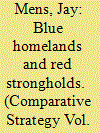

|
|
|
|
|
| Summary/Abstract |
Libya’s geopolitical importance stems from its vast energy resources, its position in relation to Southern Europe, and its position at the entrance to the Eastern Mediterranean. Over the last two years, Libya’s civil war has provided an opportunity for Russia and Turkey to compete for long-term strategic gains in the Eastern Mediterranean. This article examines the geopolitics of Libya and the involvement of Russia and Turkey in the Libyan Civil War in the context of their interests and strategies in the Eastern Mediterranean, arguing that Russian and Turkish involvement in Libya broadly follows a deeper pattern of Russian and Turkish strategy in the Mediterranean that began in the 18th Century.
|
|
|
|
|
|
|
|
|
|
|
|
|
|
|
|
| 5 |
ID:
188358
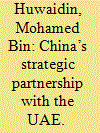

|
|
|
|
|
| Summary/Abstract |
This article investigates the strategic partnership between China and the UAE. It begins with an analysis of the concept of strategic partnership, based on the existing literature on the topic in international relations. Since there is no consensus as to the meaning of the term strategic partnership, the paper applies Thomas Wilkins’s model or framework to explain the UAE’s partnership with China. Wilkins is among the few to develop a conceptual framework or analytical model of the term. The paper then focuses on the foundation of the strategic partnership between the two countries, and goes on to analyze the prospects for the future of this partnership. The paper argues that although this partnership is strong, its future depends on two important factors. The first is UAE’s alliance with the United States, and the second, China’s relations with Iran. Driven as it is by economic considerations and a mutual desire for closer security and political cooperation, the partnership cannot, however, ignore these two important aspects.
|
|
|
|
|
|
|
|
|
|
|
|
|
|
|
|
| 6 |
ID:
188364


|
|
|
|
|
| Summary/Abstract |
Can decision-making styles impact victory and defeat in armed conflicts? To answer the question of whether decision-making styles are linked to the victories and defeats of individual tacticians, this study utilizes five general decision-making styles: Rational, Intuitive, Dependent, Avoidant and Spontaneous. The aim of this study is to examine whether one or several of the general decision-making styles (GDMS) have an impact on tactical outcomes in wargames. A total of 104 officers and academics participated in the study. The study’s foremost conclusion is that the Dependent style is significantly connected to defeat in the wargame’s dueling set up.
|
|
|
|
|
|
|
|
|
|
|
|
|
|
|
|
| 7 |
ID:
188348
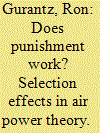

|
|
|
|
|
| Summary/Abstract |
Air power theory initially proposed that punitive attacks against civilian targets could force enemies to surrender. The current literature, however, has largely concluded that conventional bombing is ineffective as punishment. I argue that this is the result of a selection effect. By focusing only on high-profile bombing campaigns, the theory has drawn its conclusions from cases where punishment is likely to fail. This contrasts with deterrence theory, which has analyzed diplomacy in the shadow of nuclear punishment. Air power theory should follow this model by examining how the threat of bombing has influenced diplomacy and broader patterns of international politics.
|
|
|
|
|
|
|
|
|
|
|
|
|
|
|
|
| 8 |
ID:
188369
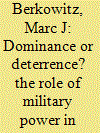

|
|
|
|
|
| Summary/Abstract |
What should be the role of military power in addressing challenges to U.S. national security interests? Should it just be used to deter armed attack by rival states? Or should military power be employed to achieve broader national objectives? The rise of great powers, global climate change, pandemic disease, and other factors and trends in the international security environment have prompted debate about the role of military power in U.S. grand strategy. This article addresses these questions by exploring the concepts of dominance and deterrence in international relations, ongoing security challenges and associated requirements for armed forces, and how military power can be integrated with other instruments of statecraft to protect and advance U.S. national interests.
|
|
|
|
|
|
|
|
|
|
|
|
|
|
|
|
| 9 |
ID:
188345
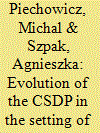

|
|
|
|
|
| Summary/Abstract |
The Common Security and Defense Policy (CSDP) represents an institutionalized attempt by European Union Member States to respond to the security challenges they confront. This paper discusses the evolution of this policy through the lens of political integration and international relations theories. The analysis integrates both the supranational and the national level, and demonstrates that European institutions have extended their privileges and sphere of influence with increasing organizational mandates. At the same time, participation by various levels in the creation of European security policies has evolved, and the inter-governmental level is often recognized as dominant. However, the question remains open whether this evolution of policy might be properly explained by several influential political theories that have shaped the European integration and security architecture in recent decades. Aspects of the CSDP institutional setting (its creation, goals and role) and the explanation of why security and defense policy is a complex dilemma of the integration process are discussed.
|
|
|
|
|
|
|
|
|
|
|
|
|
|
|
|
| 10 |
ID:
188365
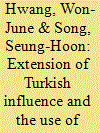

|
|
|
|
|
| Summary/Abstract |
Turkey has intervened in conflicts in surrounding states with its locally developed drones, which have been the chief factor behind its military success, and has accomplished its goals without drawing unfavorable responses from other powers. The features of drones, low economic and political cost, allowed Turkey to achieve its goals. This article analyzes Turkey’s development of drones and its interventions in Libya, Syria, and Nagorno-Karabakh, where Turkish drones proved their military effectiveness and diplomatic celerity, earning Turkey a reputation as a reliable ally and a potential defense exporter, which has raised its national pride and confidence in expanding its influence.
|
|
|
|
|
|
|
|
|
|
|
|
|
|
|
|
| 11 |
ID:
188346
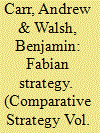

|
|
|
|
|
| Summary/Abstract |
The Fabian strategy is one of the most famous military strategies. Yet beyond notions of withdrawal and trading “space for time”, there is little clarity in the literature about how it operates. In this article, we develop a framework to explain the strategy based wearing down an adversary over time and then seeking a battlefield decision. We also examine contingent factors in shaping success or failure. In the final section, we explore what the Fabian strategy, famous for its use of time, tells us about acting strategically in the temporal domain.
|
|
|
|
|
|
|
|
|
|
|
|
|
|
|
|
| 12 |
ID:
188349
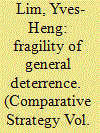

|
|
|
|
|
| Summary/Abstract |
The last decade has witnessed the gradual erosion of the maritime status quo in East Asia, as the United States proved unable to curb Chinese challenges in the East and South China seas. This article argues that this phenomenon is linked to the erosion of US general deterrence posture in the region. It examines the three main factors that have contributed to this erosion: an enduring imbalance of interests between Beijing and Washington, a rapidly evolving local balance of power, and the employment by China of strategies that have allowed it to efficiently circumvent US weak red lines.
|
|
|
|
|
|
|
|
|
|
|
|
|
|
|
|
| 13 |
ID:
188352
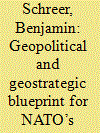

|
|
|
|
|
| Summary/Abstract |
How will the North Atlantic Treaty Organization (NATO) respond to China’s rise? At the heart of NATO’s China challenge is the need for allies to grasp the magnitude of Beijing’s emerging geopolitical challenge to the Euro-Atlantic area. Utilizing geopolitical theories developed by Halford Mackinder and Nicholas Spykman, the article argues that China is evolving into a transatlantic challenge on the Eurasian “maritime periphery.” Consequently, NATO can play a significant role in putting pressure on China’s continental direction and its efforts to extend its strategic reach into the “far seas.”
|
|
|
|
|
|
|
|
|
|
|
|
|
|
|
|
| 14 |
ID:
188357
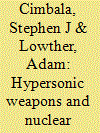

|
|
|
|
|
| Summary/Abstract |
This study explores the relationships between hypersonic weapons and nuclear deterrence. This relationship is fraught with uncertainty because the velocity of innovation in hypersonics is difficult to forecast. Nevertheless, major nuclear powers are developing hypersonic weapons, including some that can be deployed on intercontinental launchers. Hypersonic glide vehicles or cruise missiles could threaten first strike stability by reducing the time for responsive decision making in the face of perceived threats, or by evading antimissile defenses otherwise competent to deflect attacks. Attacks on space based assets and cyberattacks, combined with hypersonic missiles, could pose unacceptable risks to assured retaliation based on an assumed number of survivable launch platforms. On the other hand, analysis suggests that, in the case of the United States and Russia, going forward, strategic nuclear deterrents with currently projected modernization plans should suffice to maintain deterrence and first strike stability, barring unforeseen developments in breakthrough technologies.
|
|
|
|
|
|
|
|
|
|
|
|
|
|
|
|
| 15 |
ID:
188344
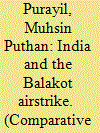

|
|
|
|
|
| Summary/Abstract |
This article argues that while India’s Balakot airstrike garnered popular attention as a hardline military approach, the role of soft power, which was very much part of it, received little or scant regard. Moving away from the popular view of the Balakot airstrike as a hard power-oriented military approach, taking a nuanced look at it from the soft power and strategic narrative vantage point, this exegesis explores both the hard and soft dimensions of power employed as means to advance India’s aims and ends. In doing so, this examination finds the strike as a smart power strategy.
|
|
|
|
|
|
|
|
|
|
|
|
|
|
|
|
| 16 |
ID:
188372
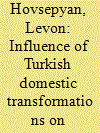

|
|
|
|
|
| Summary/Abstract |
Turkish-US relations in the last decade have been marked by tensions, crises and mutual distrust, which is unprecedented in the framework of bilateral relations. Besides international systemic variables, domestic ones are also crucial in Turkey’s current foreign policy. Therefore, in order to fully consider the ongoing transformations in the field of foreign policy and for a more comprehensive coverage of the existing tensions in Turkish-American relations, their grounds, it is necessary to explore domestic variables. In this case, we explore the impact of Turkish unit-level variables – ideological-identity and military transformations and their impact on Turkish-US relations.
|
|
|
|
|
|
|
|
|
|
|
|
|
|
|
|
| 17 |
ID:
188355
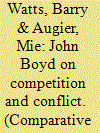

|
|
|
|
|
| Summary/Abstract |
This article reprises central aspects of John Boyd’s thinking about competition and conflict, including his unwavering reliance on analogies and connections between disciplines as disparate as fighter tactics, decision theory, history, philosophy, and physics. We trace how elements of Boyd’s ideas about winning and losing have been incorporated (or neglected) in the doctrines of the U.S. military services. Given the richness of Boyd’s ideas there is much we can learn from the view of decision making underlying the Observation-Orientation-Decision-Action (OODA) loop, for which he is best known, as well as the analogical reasoning embodied in slide presentations such as his massive “Patterns of Conflict.”
|
|
|
|
|
|
|
|
|
|
|
|
|
|
|
|
| 18 |
ID:
188353
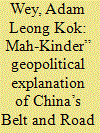

|
|
|
|
|
| Summary/Abstract |
China’s Belt and Road Initiative (BRI) has garnered a lot of attention, and worries about its impact and influence over Eurasia and Indo-Pacific. Two classical geopoliticians – Halford J. Mackinder and Alfred Thayer Mahan – had provided useful frameworks to explain China’s BRI geopolitical implications, and geostrategies to dominate the Eurasian continent and Indo-Pacific waterways with economic tools and infrastructure projects. This article claims that China’s BRI is a testament of the exceptional explanatory power of classical geopolitical theories in the practice of grand strategy in international politics.
|
|
|
|
|
|
|
|
|
|
|
|
|
|
|
|
| 19 |
ID:
188350
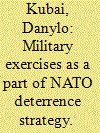

|
|
|
|
|
| Summary/Abstract |
The main aim of the article is to contribute to the better understanding of the role of military exercises for the deterrence strategy of NATO, in particular by proving the premise that military exercise is one of the most effective instrument of the military capabilities demonstration and political persuasion. Against the backdrop of the Russian revisionism and its ongoing aggression against Ukraine, NATO and its member states have substantially reinforced their deterrence capabilities. An increased number of military exercises, their geography and scale are intended to demonstrate the Alliance’s capacity and commitment to respond to potential aggression.
|
|
|
|
|
|
|
|
|
|
|
|
|
|
|
|
| 20 |
ID:
188371
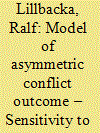

|
|
|
|
|
| Summary/Abstract |
The article assesses a model predicting outcome in counterinsurgencies based on the counterinsurgent’s exposure to external friction and strategy. Unfavorable opinions, as well as insurgents’ access to third-party support and sanctuaries, constitute sources of external friction. Strategies were categorized as mainly kinetic or population-centric. The model predicts: (1) counterinsurgents lose in contexts with high external friction regardless of strategy; (2) counterinsurgents applying a population-centric strategy win if external friction is low; (3) counterinsurgents applying a purely kinetic strategy win if external friction is low only by obtaining distinct tactical superiority. The model correctly predicted 27 of 30 examined cases.
|
|
|
|
|
|
|
|
|
|
|
|
|
|
|
|
|
|
|
|
|